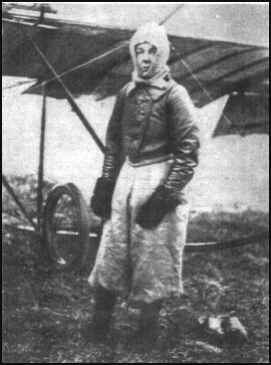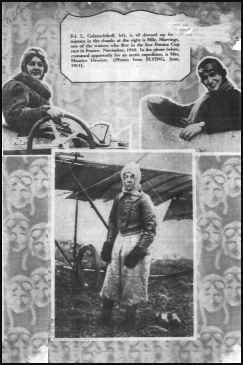

1864-1943 AKA Mrs. Maurice Hewlett |
 |
 |
|
Photo from FLYING, June 1913 Collection of David Lam |
At the Left is Mlle. Marvingt, one of the women who flew in the first Femina Cup in France, November 1910.
Frl. Galantschikoff, right, is all dressed up for sojourn in the clouds; In the photo below, costumed apparently for an arctic expedition,
is Hilda Hewlett. |
|
via email from Christine Buckley, 8-16-09 Hilda’s time at the South Kensington Schools could have led to the appointment of the young Ninian Comper as architect for the conventual church of a nunnery founded at Great Malvern by their father, the Revd George William Herbert. An order of Anglican nuns originated at his Vauxhall church, but later moved to Malvern. Comper also studied at the schools, and he and the McClures visited at least one French cathedral together in 1900 (I found a webpage on that – not sure if it’s still available). George William’s career and his interests in building and furnishing his church, not to mention the funding for them, derived from his father, William Herbert. I believe he was a successful building contractor and/or developer in early 19th C London, but without easy access to London archives I’ve struggled to create a full biography. His status is perhaps best shown in the development of West Strand, to designs by John Nash (Googling should find a webpage about this). In later life, William and his wife lived on Clapham Common in the house once occupied by Henry Cavendish (and apparently the site of Cavendish’s experiment to weigh the Earth). Their next-door neighbours were Louisa Hopgood’s brother James and his wife. James and Louisa were children of Thomas Burn (or Barn) Hopgood, who sold various kinds of upmarket fancy goods to fashionable Londoners. He and his eldest son, who continued the business, had hallmarks for the silverware they sold. (It’s possible to guess what kind of goods from court records - on-line - when one of his employees was prosecuted for helping himself to stock.) William was a friend of George Godwin, editor of a journal called The Builder, which dealt with archaeology and all kinds of contemporary interests and influences on 19th C architecture, as well as the kind of subjects one would expect. Godwin founded the Art Union of London, in order to promote the work of living artists (he has a good entry in DNB), and William Herbert was a member of the Union, praised for his natural taste by Godwin in an obituary in The Builder. William was buried in West Norwood cemetery – if you Google you can find info about West Norwood, and what I’ve managed to gather about William should appear in their next newsletter of the Friends of the cemetery. Hilda seems to have reacted against the niceties of prosperous middle-class life in the second half of the 19th C; not a great deal of this illuminates her life, except to explain (to some extent) her fluency in French. James Hopgood, her uncle, evidently supported women’s participation in any activity they chose to pursue – he was on the board of the Royal Free Hospital, and persuaded his fellow members to admit women to courses and examinations that would enable them to qualify formally as doctors for the first time. That certainly sounds like Hilda. The local schools, founded by George William and the vicar of Lambeth parish church who appointed him, trained girls as well as boys in artistic skills, so that they would find well-paid employment at the nearby Lambeth factory of Doulton, who turned to art pottery for prosperous and aspiring new middle classes of England, after earthenware drainpipes got a bit workaday and boring. A number of known Doulton Lambeth designer/decorators were female. The Art Union bought some Lambeth pieces as prizes in their lottery, and Googling produces auction catalogue entries for some. There are complex social relationships between James Hopgood and his brother John, both solicitors who acted for major London architects and builders, and the Hewletts and others with Clapham connections. Several are also in West Norwood, and I’m trying to write up what I’ve learned about them for the Friends newsletter – not easy to explain in a way that won’t make readers’ eyes glaze over inside thirty seconds. The sisters’ lives illustrate how life choices opened up to women during the second half of the nineteenth century, especially if they had the financial resources available to Mary Louisa and Hilda. It also amuses me that their father’s church was established for residents of the housing estate built on the site of the lately notorious Vauxhall Pleasure Gardens, with the sanctuary on the location of the Neptune Fountain – a new twist on the idea of ‘living water’? The vicarage had been the gardens’ manager’s house, suitably adapted for a large family. I hope some of this, at least, amuses you, and maybe fills in a bit of background to explain aspects of Hilda’s remarkable life. Christine Buckley Sedgley Dudley DY3 3SD UK |
|
via email from Christine Buckley, 8-18-09 Pleased you liked it. On-line material has been very useful in putting together what I've been able to cover. Occurred to me that there's another family factor in Hilda's determination to go her own way - her father's parents were apparently much against their only son going into the church, and weren't very pleased about his marriage to Louisa (although this may be that they didn't want Louisa to be involved in the difficulties of parish life - socially, her background was impeccable). But George William Herbert was absolutely determined to become a clergyman, and to work in a deprived area with big social needs. His parishioners adored him for it. Or Hilda's personality might have simply followed the pattern frequently observed by psychologists, that first children tend to be cautious, conventional, traditional and conservative, even backward-looking (cf Mary's interest in history and archaeology), while second children often want to break away from their background, and are often more confident people than their elders. There was in fact a daughter between Mary and Hilda - Ethel Elizabeth, b. 2 June 1860, d. 25 June 1865. She's on the 1861 census with her parents, while Mary, aged 3, is living with her uncle and aunt, next-door to her grandparents. Perhaps Ethel Elizabeth was always sickly? Maybe Hilda reacted against overprotectiveness, which would be natural in parents who had lost the previous child. Hilda would have moved up to 'second child' very early in her life. I've got a copy of one of Mary's books - shows that her husband, Edmund McClure, commissioned at least one book for SPCK from Hilda's father-in-law, Henry Hewlett. Wheels within wheels. Best wishes, Christine |
|
|
|
|
|
If you use the Google search engine on "Mrs. Maurice Hewlett", you will find about ten links. Two of
them are especially interesting. by Hewlett & Blondeau |
|
|
|
Personal communication from David Lam. 8-19-03 Editor's Note: If you have any information on this pioneer aviator please contact me. E-mail to Ralph Cooper |


|